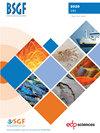基于地中海西北部褶皱冲断带沉积盆地力学的构造解释验证探讨
IF 2.6
3区 地球科学
Q2 GEOSCIENCES, MULTIDISCIPLINARY
引用次数: 5
摘要
利用地质学家对地中海西北部褶皱和冲断带6个已发表的平衡剖面的解释,对解释的地下构造结构进行了比较分析,以解决构造样式与褶皱和冲断侵位力学之间的联系。对于每个横截面示例,地理数据集和解释器使用的方法在数量和质量上都不同。在这里,我们已经检查了每个横截面的信息内容对约束结构演化情景的有用程度。每一种解释都是根据沉积盆地变形力学的考虑和断层轨迹在深度上的外推的不确定性来检验的。结果表明,每一种情况都揭示了一种特定类型的构造样式:薄皮构造或厚皮构造,断层相关褶皱,预先存在的断层样式。目前的结构分析用于确定每个横截面的力学问题的性质,以解决这将减少地质情景重建的不确定性。提出的力学边界条件可用于开发模拟或数值模型,旨在测试褶皱和逆冲侵位结构情景的力学有效性。本文章由计算机程序翻译,如有差异,请以英文原文为准。
A discussion on the validation of structural interpretations based on the mechanics of sedimentary basins in the northwestern Mediterranean fold-and-thrust belts
Using the geologist’s interpretation of 6 published balanced cross-sections in the fold and thrust belts of the northwestern Mediterranean, a comparative analysis of the interpreted subsurface structural architecture is used to address the links between the structural style and the mechanics of fold and thrust emplacement. For each cross-section example, the geo-dataset and the methods used by the interpreters are different in quantity and quality. Here we have examined how useful is the content of information of each cross-section to constrain the structural evolution scenario. Each interpretation is examined according to considerations of the mechanics of sedimentary basin deformation and how uncertain is the extrapolation of fault trajectory at depth. It is shown that each case reveals a particular type of structural style: thin-skin or thick skin tectonics, fault-related folding, pre-existing fault pattern. The present structural analysis is used to determine for each cross-section the nature of the mechanical problem to address that will reduce uncertainty on the geologic scenario reconstruction. The proposed mechanical boundary conditions could serve to develop analog or numerical models that aim at testing the mechanical validity of the structural scenario of fold and thrust emplacement.
求助全文
通过发布文献求助,成功后即可免费获取论文全文。
去求助
来源期刊
CiteScore
5.80
自引率
0.00%
发文量
18
审稿时长
>12 weeks
期刊介绍:
BSGF - Earth Sciences Bulletin publie plusieurs types de contributions :
1. des articles originaux, couvrant tous les champs disciplinaires des Géosciences, à vocation fondamentale mais également à vocation plus appliquée (risques, ressources);
2. des articles de synthèse, faisant le point sur les avancées dans un domaine spécifique des Géosciences, qu''elles soient méthodologiques ou régionales ;
3. des monographies sur la géologie d’une région donnée, assorties d’informations supplémentaires, cartes, coupes, logs, profils sismiques … publiées en ligne en annexe de l’article ;
4. des articles courts de type « express letter » ;
5. des livrets-guides d’excursion (qui suivront le même processus d’examen éditorial que les articles plus classiques) ;
6. des comptes rendus de campagnes à la mer ;
7. des articles de données géodésiques, géophysiques ou géochimiques, pouvant devenir des articles de référence pouvant conduire à des interprétations ultérieures.
BSGF - Earth Sciences Bulletin constitue également un forum pour les discussions entre spécialistes des Sciences de la Terre, de type comment-reply ou autre. Tous les articles publiés, quelle que soit leur forme, seront accessibles sans frais (articles en Open Access) sur le site de la SGF et sur celui de Geosciences World dans la mesure où les auteurs se seront acquittés d’une contribution de (Article Processing Charges – APC) de 300€ pour les membres de la SGF et 500€ pour les non-membres.

 求助内容:
求助内容: 应助结果提醒方式:
应助结果提醒方式:


